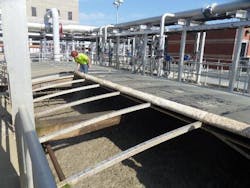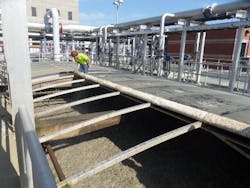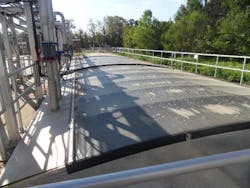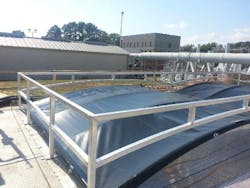Case Study: GTI covers help VA treatment plant meet odor control commitments
June 22, 2015
The Utility
The James River Treatment Plant is one of nine major treatment plants operated by the Hampton Roads Sanitation District (HRSD), a political subdivision of the Commonwealth of Virginia. Located in Newport News, Va., the facility is committed to protecting the environment and enhancing neighboring communities through a variety of wastewater treatment improvements.
The plant has an average design flow of 20 million gallons per day (MGD) (73,000 m³/d), a current annual average flow of 14 MGD (53,200 m³/d), and permit limits of 30 mg/L BOD, 30 mg/L TSS, 2 mg/L TP, and 12 mg/L TN.
The Utility's Needs
The James River Treatment Plant is bordered on one side by the James River and by houses and a park on the other. Although the utility had installed odor control systems to capture and treat foul air from parts of the plant, its conventional aeration tanks were producing low-level odors that required additional control. Surrounding residents complained.
The HRSD staff investigated the complaints and worked with neighbors to identify the odor source. An air specialist at the HRSD took samples from various areas at the plant and even went so far as to bring sample bags to neighbors. Nocardia foam from the aeration tanks was found to be the culprit.
Plant management made a commitment to neighbors that the odors would be addressed.
The Solution
The plant retained CH2M, a global engineering firm specializing in government, industrial, infrastructure, and energy programs, as its advisor to help solve the odor problem and a decision was made to capture foul air under a cover system so that it could be withdrawn and treated in a carbon system.
A variety of covers were considered. One plan involved covering one portion of the Integrated Fixed Film Activated Sludge (IFAS) tanks with fixed concrete decks that would serve as both covers and mounting surfaces for the scrubbers, as well as covering the other portion with retractable fabric covers that would provide convenient access to the tank internals. Plant staff participating in the design process noted that they needed to easily access mixers, media and the spray system within the IFAS tanks.
Plant workers needed the ability to inspect aeration patterns, clean out the anoxic section and get inside the tanks, when required. These access requirements, along with the possibility of excessive loads that could be imposed on tank walls by concrete lids and scrubbers, led to the decision to design for an alternative scrubber location and cover the tanks entirely with retractable fabric covers instead.
CH2M was aware of retractable fabric covers provided by Geomembrane Technologies Inc. (GTI), a supplier of tank and lagoon covers and containment liners for water and wastewater applications, and led an investigation into their merits. GTI was eventually selected to provide the cover solution using its retractable, structurally supported covers, custom-designed to meet the plant's specific requirements for access, equipment penetrations and rainwater management. The covers consist of retractable, plastic-coated fabric panels tensioned over low-profile, arched aluminum frames.
Later, an ANITA™ Mox treatment system -- the only one currently in the United States -- was installed to extend the plant's nutrient removal efforts. The ANITA Mox tank also required a cover for odor control, and because the tank contains mixers, media and heaters, easy accessibility was again an essential requirement. "GTI's structurally supported covers provided access and odor control so well on the IFAS tanks that we chose them for the ANITA Mox tank too," said Bob Rutherford, plant manager of the James River Treatment Plant.
The Results
GTI's structurally supported covers have helped the James River Treatment Plant continue to be a good neighbor to the surrounding community without hindering plant workers from effectively performing their jobs. "The covers worked out really well," added Rutherford.
The James River Treatment Plant was mindful to address the odor control issue aesthetically. For example, it was logical to locate the scrubbers near the covers, but it was also important to consider the neighbors' view. Care was taken in choosing a location for the scrubbers near the tanks, but out of the neighbors' sight. The covers are low profile and reliably control odors while still providing easy access to tank internals, which was crucial to plant staff.
See also:
"Sunlight-Blocking Covers Control Algae, Reduce Operational Costs at Santa Clara Utility"
"White Paper: What Makes an Effective Odor Control Cover System Design?"
About Geomembrane Technologies
Geomembrane Technologies Inc., a Global Cover and Liner Inc.® company, supplies custom tank and lagoon covers -- as well as containment liners -- to customers worldwide. With 30+ years of experience delivering solutions for demanding water and wastewater applications, GTI has grown to become a specialist in cover and liner systems. The company offers total turnkey solutions -- everything from custom-design work, to installation and commissioning, to aftercare service. Its team has completed 250+ installations in the industrial, municipal, and agricultural sectors around the globe. For more information, visit www.gticovers.com.
###



